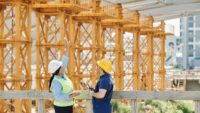It’s no surprise that workers in the construction industry are at a high risk of accidents; the industry consistently ranks as one of the most dangerous in the U.S.1 The causes of workplace injuries have remained relatively unchanged over time, with slips, trips, and falls accounting for a majority of workplace accidents.2 Yet new technologies have begun to emerge in recent years that are providing critical safety measures for workers. From wearable technology and sensors to smart helmets and helmet-based safety add-ons, there are a number of advancements that are working to provide a safer workplace.
The OSHA requires the use of personal protective equipment (PPE) for eyes, face, head, and extremities, including protective clothing, respiratory devices, and protective shields and barriers.3 Additionally, employees who are potentially exposed to the risk of head injury from impact, falling or flying objects, or electrical shock and burns, must wear a protective helmet.4 While OSHA does have measures in place to ensure workers are wearing appropriate PPE, they recently required their own employees to transition from hard hats to safety helmets, there aren’t regulations that require the use of new technologies.5
Therefore, it’s up to employers and safety managers to ensure they’re keeping informed of the latest technologies, and how they can provide enhanced workplace safety.
Wearable technology
Wearable technology is nothing new for consumers, but we’ve yet to see widespread adoption in the workplace. For those at risk of injuries throughout the day, wearable technology can sound the alarm when workers are injured, or even before an accident occurs. For example, safety vests can be equipped with sensors that are either embedded into or clipped onto the vest. These vests can monitor workers’ physiological conditions, such as blood pressure, body temperature, or pulse rate, all of which could indicate if a worker was at risk of heat stress or high blood pressure. Through a connection to smartphones or a remote computer, these sensors can send an alarm if workers’ vital signs indicate a high risk of a medical emergency. Additionally, by utilizing GPS technology, smart vests can actively monitor a worker’s location, and alert them if they enter a danger zone on a job site.
Wearable technology has extended to safety helmets as well. Sensor bands can be installed in helmets that detect workers’ health factors, such as falling asleep or fatigue. By tracking electroencephalogram (EEG) brain waves, sensor bands can identify vital signs indicating fatigue, and alert connected devices of the risk. Similar to smart vests, smart helmets can also deploy proximity sensors to detect whether objects or others are close to the worker, to give them a better sense of their surroundings. In other words, proximity sensors can sound the alarm before a potential collision and accident occurs.
Addressing rotational motion
Another helmet addition: rotational motion mitigation. First things first, rotational motion can result from oblique impacts to the head and consists of a combination of rotational forces (angular acceleration) and rotational energy (angular velocity). The transfer of this rotation to the head can result in shearing and damage to the brain’s axons, the cable transmitters of the neurons.6 Given the brain has shear properties similar to water or gel, it is typically more sensitive to rotational motion than linear motion,7 or an impact that occurs to the crown of the head. When different parts of the brain move relative to each other as a result of rotational motion, the stretching of tissues can cause concussions or other brain injuries.
This is critical for the construction industry to understand, given that research indicates when most people make an impact with the ground, or are struck by a falling object, it typically occurs at an angle. However, there are safety systems developed that are intended to help redirect rotational motion that might otherwise be transferred to the user’s head. In the event of an impact or a fall, a low- friction layer is designed to move slightly inside the helmet to help redirect forces away from the head.
Next-generation tools
A number of new developments have led to innovative tools that have brought an added level of efficiency and safety to construction job sites. For example, deploying drones for site inspections and monitoring can prevent workers from being put in unsafe scenarios and prevent the risk of a fall or other accident. Additionally, drones equipped with thermal imaging sensors can detect heat signals, giving them the ability to identify hazards such as overheated electrical wiring or equipment.
While the number of technological advancements in safety technology continues to grow, it is up to employers and safety managers to remain up-to-speed on the latest improvements to provide a safe environment for workers. The risks that workers face have changed very little over the years, but the tools and technology are continuing to evolve.
References
1. https://injuryfacts.nsc.org/work/industry-incidence-rates/most-dangerous-industries/
2. https://www.bls.gov/spotlight/2022/workplace-injuries-and-job-requirements-for-construction-laborers/home.htm#:~:text=Workers%20in%20construction%20and%20extraction,96%20occurred%20among%20construction%20laborers.
3. https://www.osha.gov/laws-regs/regulations/standardnumber/1926/1926.95#:~:text=Protective%20equipment%2C%20including%20personal%20protective,of%20hazards%20of%20processes%20or
4. https://www.osha.gov/laws-regs/standardinterpretations/2004-02-20#:~:text=29%20CFR%201926.100(a)%20states,be%20protected%20by%20protective%20helmets.
5. https://www.osha.gov/news/newsreleases/trade/12112023
6. Gennarelli et.al. (1987). “Directional dependence of axonal brain injury due to centroidal and non-centroidal acceleration,” in Proceedings of the 31st Stapp Car Crash Conference (Warrendale, PA: Society of Automotive Engineers).
7. Kleiven, S (2007). “Predictors for traumatic brain injuries evaluated through accident reconstructions,” Stapp Car Crash J, vol. 51, pp. 81–114, Oct. 2007.
7. Gennarelli et. al. (1972). “Pathophysiological responses to rotational and translational accelerations of the head,” in Proceedings of the 16th Stapp Car Crash Conference, 1972 (Warrendale, PA: Society of Automotive Engineers).



